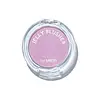What's inside
What's inside
 Key Ingredients
Key Ingredients

 Benefits
Benefits

 Concerns
Concerns

 Ingredients Side-by-side
Ingredients Side-by-side

CI 77891
Cosmetic ColorantPolymethyl Methacrylate
Dimethicone
EmollientDimethicone/Vinyl Dimethicone Crosspolymer
Skin ConditioningDiphenylsiloxy Phenyl Trimethicone
Skin ConditioningMica
Cosmetic ColorantPhenyl Trimethicone
Skin ConditioningHydrogenated Poly(C6-14 Olefin)
EmollientDiisostearyl Malate
EmollientSilica
AbrasiveSynthetic Fluorphlogopite
Polymethylsilsesquioxane
Caprylyl Glycol
EmollientGlyceryl Caprylate
EmollientCI 75470
Cosmetic ColorantTriethoxycaprylylsilane
Aluminum Hydroxide
EmollientLauroyl Lysine
Skin ConditioningCI 77510
Cosmetic ColorantTin Oxide
AbrasiveTocopherol
AntioxidantCI 77891, Polymethyl Methacrylate, Dimethicone, Dimethicone/Vinyl Dimethicone Crosspolymer, Diphenylsiloxy Phenyl Trimethicone, Mica, Phenyl Trimethicone, Hydrogenated Poly(C6-14 Olefin), Diisostearyl Malate, Silica, Synthetic Fluorphlogopite, Polymethylsilsesquioxane, Caprylyl Glycol, Glyceryl Caprylate, CI 75470, Triethoxycaprylylsilane, Aluminum Hydroxide, Lauroyl Lysine, CI 77510, Tin Oxide, Tocopherol
Dimethicone
EmollientMica
Cosmetic ColorantTitanium Dioxide
Cosmetic ColorantDimethicone/Vinyl Dimethicone Crosspolymer
Skin ConditioningHydrogenated Polydecene
EmollientPhenyl Trimethicone
Skin ConditioningSilica
AbrasiveLauroyl Lysine
Skin Conditioning1,2-Hexanediol
Skin ConditioningAluminum Hydroxide
EmollientGlyceryl Caprylate
EmollientStearyl Dimethicone
EmollientKaolin
AbrasiveUltramarines
CI 17200
Cosmetic ColorantHc Red No. 20
Hc Yellow No. 4
Ingredients Explained
These ingredients are found in both products.
Ingredients higher up in an ingredient list are typically present in a larger amount.
Aluminum Hydroxide is a form of aluminum. It can be naturally found in nature as the mineral gibbsite. In cosmetics, Aluminum Hydroxide is used as a colorant, pH adjuster, and absorbent.
As a colorant, Aluminum Hydroxide may add opacity, or reduce the transparency. Aluminum hydroxide is contains both basic and acidic properties.
According to manufacturers, this ingredient is an emollient and humectant. This means it helps hydrate the skin.
In medicine, this ingredient is used to help relieve heartburn and help heal ulcers.
There is currently no credible scientific evidence linking aluminum hydroxide in cosmetics to increased cancer risk.
Major health organizations allow the use of aluminum hydroxide in personal care products and have not flagged it as a carcinogenic risk at typical usage levels.
Learn more about Aluminum HydroxideDimethicone is a type of synthetic silicone created from natural materials such as quartz.
What it does:
Dimethicone comes in different viscosities:
Depending on the viscosity, dimethicone has different properties.
Ingredients lists don't always show which type is used, so we recommend reaching out to the brand if you have questions about the viscosity.
This ingredient is unlikely to cause irritation because it does not get absorbed into skin. However, people with silicone allergies should be careful about using this ingredient.
Note: Dimethicone may contribute to pilling. This is because it is not oil or water soluble, so pilling may occur when layered with products. When mixed with heavy oils in a formula, the outcome is also quite greasy.
Learn more about DimethiconeThis ingredient is a silicone used to improve the texture of products and absorb oil. It does not get absorbed into the skin.
Like other silicones, Dimethicone/Vinyl Dimethicone Crosspolymer helps condition the skin by creating a barrier. In this sense, it can act as an emollient and trap moisture in.
This ingredient is a type of elastomer.
Learn more about Dimethicone/Vinyl Dimethicone CrosspolymerGlyceryl Caprylate comes from glycerin and caprylic acid, a fatty acid from coconut. It has emollient and emulsifier properties.
As an emollient, it helps hydrate your skin. Emollients work by creating a barrier on your skin to trap moisture in, helping to keep your skin soft and smooth.
On the other hand, emulsifiers prevent ingredients (such as oil and water) from separating.
Learn more about Glyceryl CaprylateThis ingredient comes from a fatty acid (lauric acid) and amino acid (lysine). It is used to add a silky feel to cosmetics.
According to a manufacturer, its fatty acid base leaves a silky feeling on the skin. It also has emollient properties because of this. Emollients help soften skin by preventing water from evaporating.
Lauroyl lysine is barely soluble in water.
Learn more about Lauroyl LysineMica is a naturally occurring mineral used to add shimmer and color in cosmetics. It can also help improve the texture of a product or give it an opaque, white/silver color.
Serecite is the name for very fine but ragged grains of mica.
This ingredient is often coated with metal oxides like titanium dioxide. Trace amounts of heavy metals may be found in mica, but these metals are not harmful in our personal products.
Mica has been used since prehistoric times throughout the world. Ancient Egyptian, Indian, Greek, Roman, Aztec, and Chinese civilizations have used mica.
Learn more about MicaPhenyl Trimethicone is a silicon-based polymer. It is derived from silica.
Phenyl Trimethicone is used as an emollient and prevents products from foaming.
As an emollient, it helps trap moisture in the skin. It is considered an occlusive.
Learn more about Phenyl TrimethiconeSilica, also known as silicon dioxide, is a naturally occurring mineral. It is used as a fine, spherical, and porous powder in cosmetics.
Though it has exfoliant properties, the function of silica varies depending on the product.
The unique structure of silica enhances the spreadability and adds smoothness, making it a great texture enhancer.
It is also used as an active carrier, emulsifier, and mattifier due to its ability to absorb excess oil.
In some products, tiny microneedles called spicules are made from silica or hydrolyzed sponge. When you rub them in, they lightly polish away dead skin layers and enhance the penetration of active ingredients.
Learn more about Silica